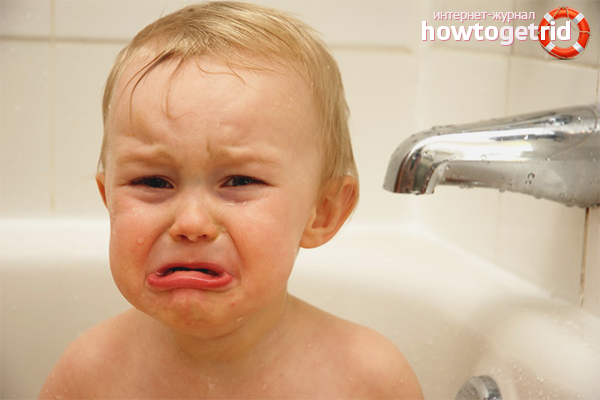The content of the article
The overwhelming majority of newborn children are very fond of swimming, because water for them is the natural environment in which they lived most of their lives. Fear of bathing arises later, to a more conscious age. Psychologists note that in many ways the fear of water and bathing is associated with adult mistakes. If mom and dad did not organize the bath properly, did not provide for any nuances, or were nervous and anxious, this condition can be transmitted to the child. Today we’ll talk about the children's bathing fear - how and why it arises, how to organize bathing and wash the baby without tears and screams.
Why is the child afraid of water
Often parents, seeing that the baby does not want to swim, put him in the water by force, because you need to wash. And they make a big mistake. Do not force the child to do what he is afraid of. This can cause psychological trauma to the child and form a phobia for life. It is very important to identify the true cause of fear, especially if it has appeared recently.
- Most often, children are afraid of water entering their mouth, nose and ears. Careless movement, leaving your head under water for even a second can generate intense fear based on the instinct of self-preservation.
- Sometimes children are afraid of cold or hot water, especially if the baby was lowered there immediately.
- Some mothers try to protect the child from getting water on their faces and put on a special visor on their heads. If it suddenly falls or it is decided to remove it, then the water that has got on your face can become a serious surprise and the baby is really scared.
- Fear of bathing may occur due to careless falling or hitting the edge of the bath. Kids have excellent associative thinking, which captures - it was painful in the bathroom, so the bath is pain.
- Very often, children are afraid to swim due to the fact that they need to wash their hair. The process of washing their hair is very difficult for them, since there is a high risk of water getting into the eyes, ears, nose and mouth. In addition, the baby may be scared by the shampoo that nips the eyes.
- Another common cause of fear is the pain the baby experiences when it enters the water. If there are diaper rash, cracks, rashes on the delicate skin of the crumbs, then getting water into the wound can be painful.
In addition, the baby can be simply anxious, especially if the mother is afraid, her hands are shaking, and she constantly repeats "Do not be afraid, do not be afraid." The baby understands that there really is something to be afraid of, and begins to abandon the dubious undertaking.
How to prepare for a calm and safe swim
First you need to decide where you will bathe the child. In some cases, fear of water arises in children in the case when the parents decide to change the cramped bath to the water expanses of a large bath. The baby in this case can be scared, especially if he is not even a year old. The fact is that close water is associated with a safe maternal womb, and in a large bath the baby feels anxious. Therefore, if possible, do not transfer the child to a large bath, at least until the fear of bathing is completely gone.
When collecting a bath, pay attention to the temperature of the water. It should be as comfortable as possible. Usually water is checked with an elbow - the skin should be nice. And for the smallest, it is better to measure the water temperature with a thermometer, it should be close to body temperature - about 37 degrees. If you want the water to be slightly hotter or colder, you need to change the temperature gradually, as the baby gets used to it.Hot water can be added to the bath only if you take the baby out of the bath, mix the water and lower the baby back into the water. Pay attention to the shampoo that you use to wash your head and body. Today, almost all shampoos for children do not pinch their eyes, but it's still worth checking this fact.
Before you lower the child into the water, you need to check his skin. If there are open wounds from swimming, it is better to refuse for some time. Do not use visors for the face. Such devices have good intentions, but water is not evil. The kid must learn to perceive water, he must understand that water can flow over the face. Just try to hold your baby so that water does not flow into your ears, nose, mouth and eyes. Unlearning from such a protective visor will be much more difficult, the baby may be scared. Be careful to hold the child firmly and securely so that he does not slip out of his hands. The bottom of the bath should be grooved so that the baby does not slip and does not move out. If the baby is already bathing in a large bath, he will need a special rubber mat to the bottom.
If the child still has fear, do not introduce any new devices - for example, a circle for the neck. In general, such a circle is very useful and convenient for both mom and child. With it, a woman will not have to constantly support the crumb in a bent position, and the baby will get real freedom of action. But remember that new devices are possible only when the baby gets used to it. But this does not apply to new toys! Just the same, they can play an important role in the child’s addiction to water. Put the baby in a small amount of water (if he is more than six months old), throw new toys in the bathtub and give the child the opportunity to just play with them. And yet, you need to know the main rule of swimming. In no case do not leave the child alone in the water, even for a second. Try to take a towel with you in advance, and all that may be needed for swimming. Do not leave your child, it is very dangerous.
What to do if the child refuses to swim
But what if the baby already has this fear? How to overcome it and, finally, start water procedures? Here are some tips and tricks from experienced moms that may be useful to you.
- In some cases, you can take a bath with your child. Gather some water, grab the baby in your arms and dip into the water together.
- Bathing itself should be taken as something joyful and cheerful. Tell your baby in a perky voice that you will go swimming soon. Say that bathing is a reward for eating soup or cleaned toys. A child should perceive water procedures as a fun game, and not as a duty.
- You can agree with older children. Explain to the baby that if he does not wash his hair, a cockroach will settle in his hair and live there.
- In some cases, unpleasant memories are associated with the word "swim". If the baby is crying from this one word, do not pronounce it. Say “rinse”, “swim”, etc.
- Young children quickly forget all the bad. Therefore, if the baby cries and does not want to swim in anything, just postpone the water procedures for a while. After 3-4 days, invite the child to swim again, for sure he will agree.
- You can buy a child a variety of water toys, with which he will swim without problems. These are watering cans, water pistols, mills, and cups. A lot of children like to swim precisely because of such toys.
- A child can be offered such a game. Take the balls from table tennis or any other small items that do not sink. Dip them in a cup of water and ask the baby to blow. When the child is amused, invite him to transfer the game to the bath, because there is much more space. By the way, such articulation exercises are very useful for the development of speech.
- There are many toys on the suction cups that are attached to the edge of the bathtub - colorful pictures can also attract a baby.
- Show your child how brave ducks and brave rubber dolphins swim in water, splash and play.
- In some cases, changing the scene helps to get rid of the unpleasant associative chain. If the baby is crying, as soon as you bring it into the bath, transfer the bath to the kitchen or room to change the situation.
- No need to bathe a child when something hurts him or the baby is in a bad mood.
- Older children can make soap bubbles in the water. The fact is that soap bubbles hide the real border of water and air, during the game the baby will not notice how it appears in the water.
- In some cases, this method helps - you need to put the child in the bath before the water has accumulated. And only then close the drain when the crumbs get used to and play out.
- If a child once swallowed water, this can lead to great fear, and the baby will categorically refuse to bathe. In this case, you need to temporarily stop collecting water in the bath, and water procedures should be carried out with the help of a shower.
- In no case do not teach your child to swim until he completely gets used to the water. You will still have time to practice the skill. Moreover, experienced coaches recommend learning to swim at a more conscious age - at 5-6 years.
Bathing and water procedures are one of the most important components of baby hygiene. Bathing is not only a way to maintain clean skin and body. In water, the load on the fragile children's body is reduced, the baby can move and move independently, all of his muscles are strengthened. Water perfectly eliminates both weak and excessive tone of the limbs. It is not for nothing that our ancestors believed that if the baby is often bathed, he will grow much faster. It is in your hands to form the child’s right attitude towards water. Having loved water once, the baby will always love swimming. And this is the guarantee of health and strong immunity!
Video: the child is afraid to swim - how to help him?











Submit